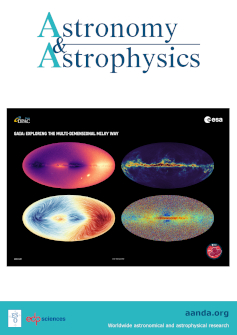TESS 南方连续观测区内的 A-F 光谱型周期变星
IF 5.4
2区 物理与天体物理
Q1 ASTRONOMY & ASTROPHYSICS
引用次数: 0
摘要
目的。我们的主要目标是对 TESS 卫星南部连续观测区内 A-F 级恒星的可变性进行准确识别和分类。亮度限制设定为 10 等,以确保我们的结果具有最大的可靠性,并允许使用小型望远镜进行光谱跟踪观测。我们的目标是将我们的发现与现有的变星星表进行比较。我们使用 TESS 的光变曲线及其傅立叶变换对样本中的恒星进行人工分类。与其他星表进行交叉比对,以识别污染物和假阳性。我们确定了 1171 颗变星(占样本的 51%)。在这些变星中,67%有明确的分类,其中包括δ Sct 和 γ Dor 脉动星及其混合星、自转变星和食双星。我们举例说明了变星的典型代表,并讨论了模棱两可的情况。我们发现了20对频率相同的恒星,并确定了变星的正确来源。此外,我们还发现另外12颗恒星的变异是由附近暗淡的大振幅变星的光线污染造成的。为了将我们的样本与其他变星星表进行比较,我们定义了两个参数来反映变星识别和分类的一致性。比较结果表明,在分类方面的分歧从 52%到 100%不等,令人费解。不过,如果我们假设没有特定类型的恒星只被标记为变星,那么一致性就相对较好,从 57% 到 85%(分歧 15-43%)不等。我们已经证明,TESS分类优于基于其他测光巡天的分类。恒星变率的分类非常复杂,需要仔细考虑。在使用目录分类时应谨慎。本文章由计算机程序翻译,如有差异,请以英文原文为准。
Periodic variable A-F spectral type stars in the southern TESS continuous viewing zone
Aims. Our primary objective is to accurately identify and classify the variability of A-F stars in the southern continuous viewing zone of the TESS satellite. The brightness limit was set to 10 mag to ensure the utmost reliability of our results and allow for spectroscopic follow-up observations using small telescopes. We aim to compare our findings with existing catalogues of variable stars.Methods. The light curves from TESS and their Fourier transform were used to manually classify stars in our sample. Cross-matching with other catalogues was performed to identify contaminants and false positives.Results. We have identified 1171 variable stars (51% of the sample). Among these variable stars, 67% have clear classifications, which includes δ Sct and γ Dor pulsating stars and their hybrids, rotationally variables, and eclipsing binaries. We have provided examples of the typical representatives of variable stars and discussed the ambiguous cases. We found 20 pairs of stars with the same frequencies and identified the correct source of the variations. Additionally, we found that the variations in 12 other stars are caused by contamination from the light of faint nearby large-amplitude variable stars. To compare our sample with other variable star catalogues, we have defined two parameters reflecting the agreement in identification of variable stars and their classification. This comparison reveals intriguing disagreements in classification ranging from 52 to 100%. However, if we assume that stars without specific types are only marked as variable, then the agreement is relatively good, ranging from 57 to 85% (disagreement 15–43%). We have demonstrated that the TESS classification is superior to the classification based on other photometric surveys.Conclusions. The classification of stellar variability is complex and requires careful consideration. Caution should be exercised when using catalogue classifications.
求助全文
通过发布文献求助,成功后即可免费获取论文全文。
去求助
来源期刊

Astronomy & Astrophysics
地学天文-天文与天体物理
CiteScore
10.20
自引率
27.70%
发文量
2105
审稿时长
1-2 weeks
期刊介绍:
Astronomy & Astrophysics is an international Journal that publishes papers on all aspects of astronomy and astrophysics (theoretical, observational, and instrumental) independently of the techniques used to obtain the results.
 求助内容:
求助内容: 应助结果提醒方式:
应助结果提醒方式:


